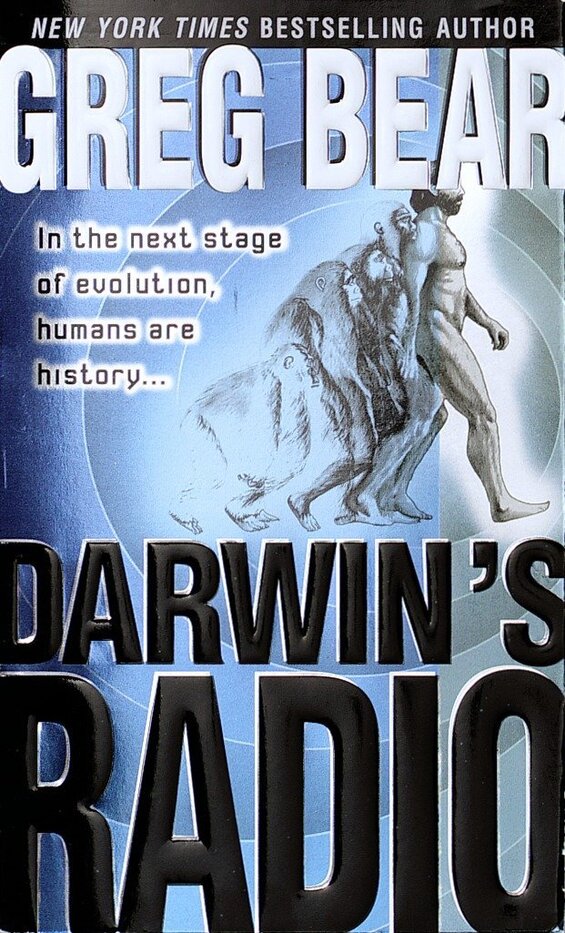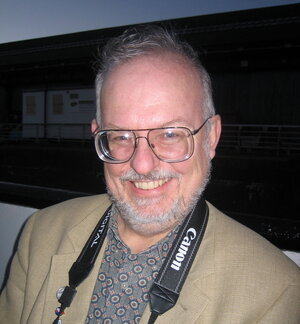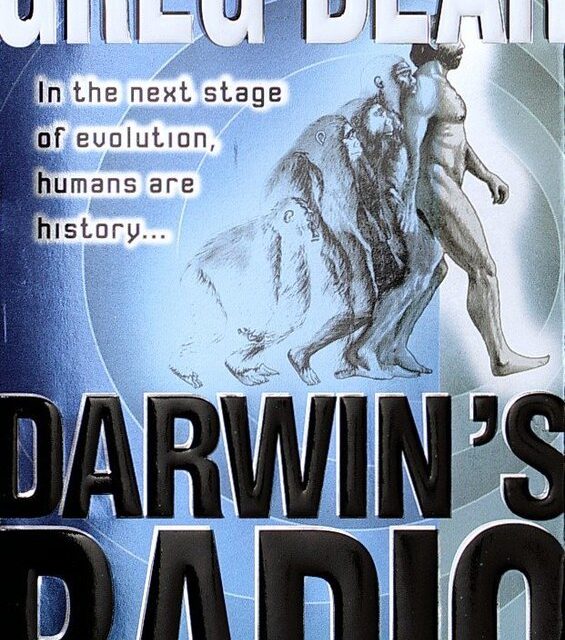
Evolutionary biologists tend to agree with Charles Darwin that new species can emerge only gradually over many generations. But in recent decades some have advanced a contrarian view termed punctuated equilibrium, or what I prefer to call fast-tracked evolution. They contend that evolution manifests itself in spurts, making it possible for new species to develop rapidly in response to threatening changes in the environment. And Greg Bear’s Nebula Award-winning 1999 novel rests on that controversial hypothesis. In Darwin’s Radio, the process gives rise to a new species of human. Gifted hard-science-fiction author that he is, Bear builds a convincing case grounded in an understanding of the human genome.
Four parallel plots
Darwin’s Radio is a complex tale crafted of several parallel storylines. In the novel’s early chapters, we follow a maverick paleontologist on a dangerous and illegal hunt in the Italian-Swiss Alps for the frozen corpses of a Neanderthal family. Miles away in the Republic of Georgia, a CDC virus hunter has turned up proof that villagers have been murdering women who give birth to deformed babies. Meanwhile, a biological researcher has uncovered startling new evidence that a live virus has emerged from the “junk DNA” that dominates the human genome. And back in the United States, bureaucrats in the Department of Health and Human Services are struggling with reports of gruesome spontaneous abortions from around the country. All these disparate plots eventually converge, as the course of our species’ development shifts through what I’m calling fast-tracked evolution—and the result is shattering.
Darwin’s Radio (Darwin #1 of 2) by Greg Bear (1999) 544 pages ★★★★☆
Winner of the 2000 Nebula Award for Best Novel

Four central characters anchor the story
Kaye Lang
Kaye Lang is a brilliant young microbiologist traveling in the Republic of Georgia on a quest to conclude a contract with a local scientific research laboratory for her and her husband’s start-up biotech firm. Then the United Nations peacekeeping mission conscripts her into a forensic mission. They rush her to a remote village to investigate graves they believe may represent an example of ethnic cleansing. The graves hold the remains of murdered women and strangely deformed fetuses. And that discovery will cast light on Kaye’s research into an anomalous genetic discovery that seems likely to explain fast-tracked evolution and earn her a Nobel Prize.
Mitch Rafelson
Paleontologist Mitch Rafelson is an outcast in his profession and widely regarded as a criminal. Years earlier, on a dig in the American Northwest, he had uncovered a ten-thousand-year-old skeleton. The Native American tribes of the area claimed the remains as one of their ancestors. And the law was on their side. But Mitch, who was convinced the man showed signs of a different lineage, spirited off the bones for study. Now, ostracized after losing a high-profile court case, he was vacationing in Europe when two adventurers roped him into joining them on a trek high into the Alps. They promised him a view of another ancient set of remains in a cave. And when he does so, he finds startling evidence of fast-tracked evolution—and nearly loses his life.
Christopher Dicken
Christopher Dicken, a veteran virus hunter for the CDC, is, like Kaye Lang, in the Republic of Georgia. But for him the graves in that remote village represent the extension of a pattern he has observed throughout Ukraine, Georgia, and Turkey. He suspects an ancient disease, hitherto undiscovered, had afflicted women in the region for decades, causing them to abort their fetuses—and arouse superstitious fear among others in their villages. Christopher (never “Chris”) believes Kaye’s hypothesis that the origin of the disease lies in the human genome.
Mark Augustine
Mark Augustine is the director of the Centers for Disease Control and Christopher’s boss. He has been looking into troubling reports from around the US about a virus causing miscarriages. In what may be related, he is also following up rumors that an unidentified virus may be a “human endogenous retrovirus, or HERV” that has somehow spontaneously emerged from the women’s genome and infected them. “So far, no one outside the CDC had yet put the two together.” But Mark presses Christopher into service on his return to investigate the increasingly numerous reports of what he now calls “Herod’s flu.”
In Darwin’s Radio, each of the four principal characters will be tested as never before. Because the early incidences of Herod’s flu will mount into a nearly universal epidemic. Kaye’s genetic hypothesis will prove to hold the key to understanding the phenomenon. And Mitch’s discovery high up in the mountains will eventually cast further light on what will prove to be a major event in the evolution of the human species—proof that what is happening is accelerated evolution. As the four strands of the story converge, we see that what happened in that remote Georgian village, and in others Christopher has discovered nearby, offers merely a hint of the explosive reaction among the American people.
The science behind the novel
Greg Bear does not suffer foolish readers lightly. Throughout the text of Darwin’s Radio, you’ll encounter researchers using scientific terms that are likely to be unknown, confusing, and off-putting unless you know a great deal more biology than I do. Bear includes “A Short Biological Primer” as an appendix as well as a “Short Glossary of Scientific Terms.” But they’re written using the same jargon. I found them only marginally useful. But as I gradually made my way through the story, the pieces of the puzzle started fitting together despite the jargon. What follows, then, is my attempt to explain in plainer language how Bear explains fast-tracked evolution in this always-fascinating story.
How Greg Bear explains fast-tracked evolution
The human genome consists of some three billion fundamental units of DNA called “base pairs.” However, only an estimated eight to fifteen percent of these three billion base pairs are biologically functional and play a role in our genetic heritage. The rest are what is sometimes called “junk DNA.” For long it was thought to have no obvious function. However, it’s not junk at all. Scientists are finding more and more meaningful activity grounded in it. For example, some five to eight percent of the genome are human endogenous retroviruses (HERV), which are ancient viruses that have become embedded in our DNA.
In Darwin’s Radio, one of these HERVs unexpectedly emerges from the genome and infects pregnant women. At the CDC, the virus is called SHEVA, and it is believed to cause “Herod’s flu.” In men, the symptoms are mild. But in women the consequences are grave. And in ways that will become clear over time, the SHEVA epidemic unlocks fast-tracked evolution on a wide scale. American society—and the world—will never be the same.
If I explain anything more, I’ll spoil the story. Just keep in mind that the science on which this story is based is controversial at best.
About the author

Greg Bear (born 1951) sold his first science fiction story at the age of sixteen. To date, he has written more than fifty books, most of them hard science fiction novels. Bear has won both the Hugo and Nebula Awards as well as numerous other accolades for his fiction. He is married to Astrid Anderson, daughter of the science fiction and fantasy authors Poul and Karen Anderson. They live near Seattle. The couple has two children.
For related reading
I’ve also read and enjoyed The Forge of God – Forge of God #1 (Greg Bear’s powerful tale of interstellar conflict) and Blood Music (A biological technothriller about genetic engineering). And if you’re the type who always reads the reviews before tackling the book, you might want to check out the sequel to Darwin’s Radio: Darwin’s Children (A novel view of the posthuman future).
For another novel on the same general theme—but much inferior—see Upgrade (Human++ #1 of 3) by Dima Zales (On the road to transhumanism).
For more good reading, check out:
- These novels won both Hugo and Nebula Awards
- The ultimate guide to the all-time best science fiction novels
- The top science fiction novels
- The top 10 dystopian novels
- 10 new science fiction authors worth reading now
And you can always find my most popular reviews, and the most recent ones, on the Home Page.


























